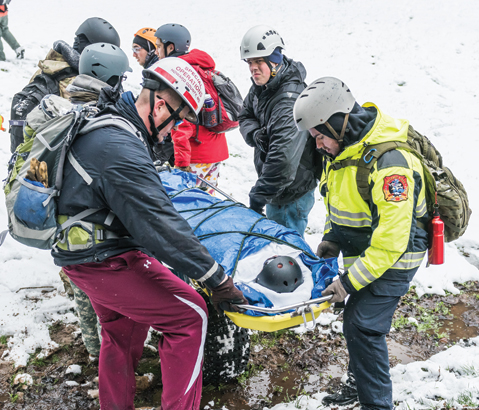You’re hiking in the woods. A branch snaps…and suddenly you’re on the ground, immobilized by pain. As the sun begins to set, you wonder what you’ll do next, and who might come to your rescue…
Wilderness Warriors
It takes intense training to rescue and provide excellent medical care to patients under normal, predictable circumstances. To do the same thing in untamed wilderness? Well, that takes an extra layer of grit.
That’s why each spring for the last 33 years, UMBC’s Emergency Health Services (EHS) program has sent a group of hardy students deep into the forest to learn the finer points of search and rescue. Over the course of three days, in remote Garrett County, 17 students in this unique program will practice everything from orienteering to “dead reckoning” and learn to be a team – all under the careful watch of a community of alums and emergency volunteers.
No matter the weather, these Retrievers are ready for anything.
Story by Jenny O’Grady
Photographs by Marlayna Demond ’11
“Everybody Helps Everybody”
A fresh layer of snow covers Abbott’s Orchard, a small clearing near the lodge in New Germany State Park where students will spend their weekend training. The first challenge: pitching tents in less-than-optimal conditions. Later, as the teams gather at benches in units to compare notes and brace themselves for the weekend ahead, they meet the more than 30 alumni and friends from across the EHS program’s history and nearby rescue operations who will teach them everything they know – including bear safety.
“The biggest thing that draws them back is the camaraderie, and the fact that they overcome adversity together,” says Cole Brown ’88, EHS, who leads the training staff for the weekend. Through that, “they build friendships, and they learn how to put aside their personal views and from there come to be a team. So they go from being an I to a we.”
[nivoslider id=”4172″]
Spider Straps and Stokes Baskets
Emergency personnel refer to the “golden hour” as the all-too-limited time between the occurrence of an injury and the best window of opportunity for care to be given. Finding success as a rescuer means not only understanding how to use the best tools for the job – but how to do it quickly and carefully. To prepare for real-world rescue scenarios, EHS students practice everything from orienteering – using compass and paces to estimate locations in unknown terrain – to strapping victims with unknown injuries to back boards, to rolling them safely to care in a wheeled basket. They also study standardized lost person behaviors.
“This training is absolutely essential in wilderness medicine because you can’t always get a helicopter to the scene,” says Jeff Mitchell, a clinical professor in the department, who has run this exercise since its start in 1983.
[nivoslider id=”4259″]
Sweep and Clear
With tools and equipment skills at the ready, students take to the woods searching for clues – and hoping to find their patients in time to be helpful. Alumni like Raven Gronsbell ’15, EHS, who now works as a paramedic in Kent County, volunteer to act as “victims,” often sitting quietly for hours in the woods before being found by student rescuers.
“I will be out there sitting in the woods… waiting… and hoping they’re fast,” says Gronsbell, who in a nighttime search portrayed “Casey Wood,” a teen who wandered away from her family while exploring. Gronsbell spoke so highly of the class that her math major sister, Jessica, decided to take part this year. “I also really enjoy helping out with the training. That’s why I come back.”
[nivoslider id=”4281″]
Read more about the EHS program: Practicing What They Preach
Tags: CAHSS, EHS, Spring 2017




